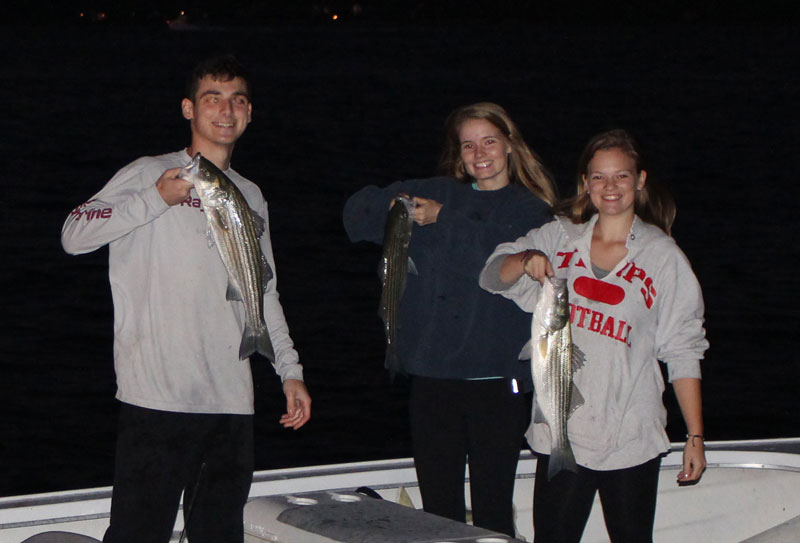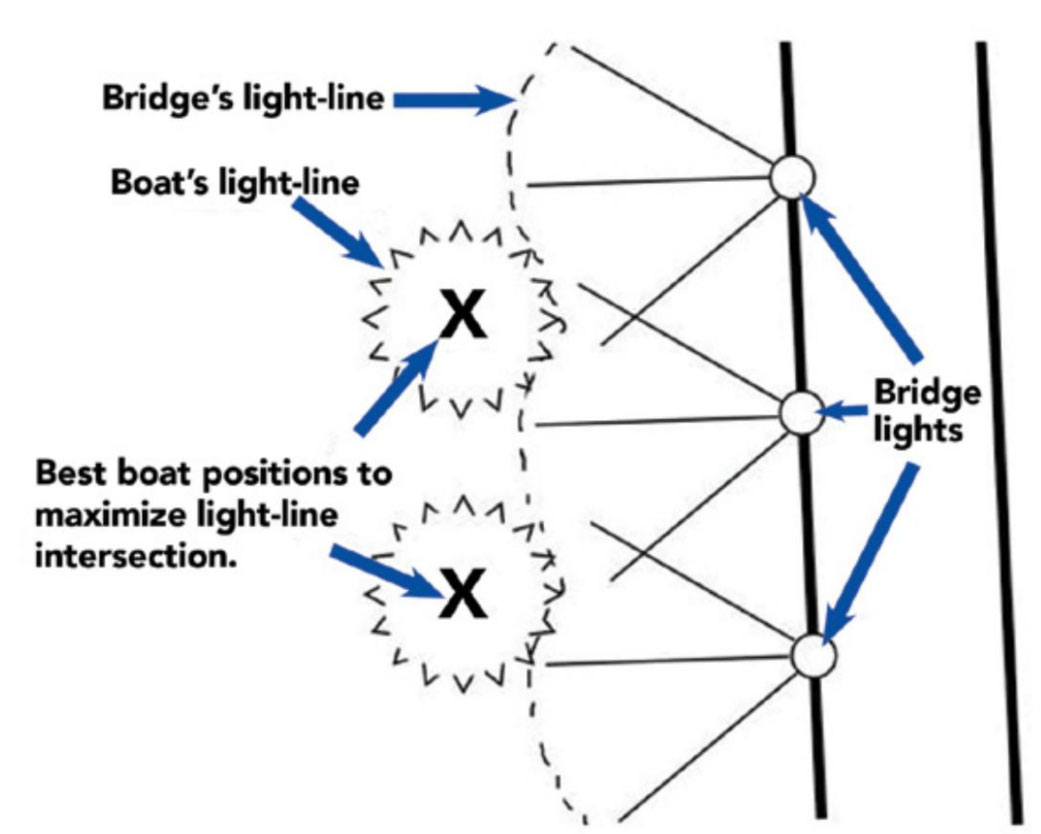Maybe your idea of a good time fishing means hauling up one crappie after the next, or maybe you sit at the opposite end of the angling spectrum and tugging on tuna is more your style. Whatever fishery gets you jazzed up one thing is for sure: when the heat becomes oppressive it has just as big an impact on the fish as it does on us humans. It can become nearly impossible to get a bite on reservoirs that you know are teeming with fish. At times you can literally see your quarry swimming in a river with your own eyes, yet are unable to tempt them into striking. And your offerings may go untouched on the Bay even as the meter indicates hordes of fish are under the boat. During such times fishing at daybreak and sunset is commonly the move. But fish that are active only at dawn and dusk usually provide you with mere minutes of action before returning to their funk. How can you possibly get those finned critters to start snapping for hours at a time? Become a creature of the night.

Lights for Night Fishing
At night fish are attracted to light — any kind of light. That leaves you with two options: fish around preexisting lighting, or come armed with your own.
Preexisting lighting can be found at bridges, piers, and sometimes along bulkheads or sea walls next to large facilities. All will attract hordes of bait, which in turn attracts predators. And when fishing from a boat or an unlighted pier you can drop your own lights into the water. Large cylinder lights can be weighted at one end and hung over the side, and all sorts of colored lights are available, but green attracts the most fish, period. I spent over 50 hours testing white, pink, blue, and green Hydroglow and Electralume lights on a series of overnighters, hanging different color lights off each side of the boat and comparing the results. No color ever had even half as much bait in it as the green. (Blue came next in effectiveness followed by white and then pink.)

As a general rule of thumb you won’t want to fish right in the middle of the light, but instead, make your casts and place your baits at the edges of the light-line, where the illumination fades out into darkness. While bait is often in the most illuminated areas, the hunters will lurk in the darkness just outside of it and wait for careless quarry to wander too close to the edge.
Preexisting lights do have an advantage over lights of your own in that over time, fish become conditioned to return to them night after night. Talk to any dock owner with a lighted pier, and they’ll be happy to describe the schools of fish and sometimes the specific individuals that return night after night. So if you’re fishing in a river with lots of lighted piers or a bridge that’s brightly lighted, you may be better off fishing the existing lights as opposed to picking out a dark spot and dropping down your own. In the best-case scenario, however, you won’t do either — you’ll do both.
Bridges are killer for this tactic, because they have long, continuous light-lines stretching from one shore to the other. Try to anchor your boat just outside of the light-line in a promising area, and deploy your light so that its light-line intersects with the preexisting one. Just as two intersecting structures are more likely to hold fish than a single one, the intersecting lights draw in fish like moths to a porch light.

Night Fishing Tips
Okay: you’re in position and ready to catch fish. What next? First, remember that it’s smart to come armed with bait because it’s usually tougher to fish artificials at night. That’s not to say it can’t be done effectively (stick with dark colors like black and purple), but it is tougher since the fish are hunting by using senses other than sight more so than they do in the daylight. So as a general rule, bait that smells or wiggles wins out.
Even better than coming armed with bait is coming armed to catch live baits on the spot. Matching the hatch is always a good move, and if you can pull a livie out from the lights, put it on a hook, and send it right back out, you have an excellent chance at hooking up.
Just what armaments you’ll need depends on the environment and the type of baits you’re attracting. Offshore this means having squid jigs to pull in live squid, and/or Sabikis to catch tinker mackerel. In the Bay where peanut bunker are likely to show up having a cast net at the ready is in order. And on a reservoir a dip net and a fast arm can help you fill up the bait bucket.
Night fishing certainly isn’t for everyone. But if you don’t mind missing out on some sleep and you want to enjoy hours of action during the dog days of summer, night fishing is the move.
Gear for Night Fishing
Night fishing does require a few special items you might not otherwise carry. Obviously having a flashlight on hand is a good idea. But it won’t help much when you’re using both hands to tie knots or bait hooks, so make sure you have a hands-free headlamp or a light you can clip onto the brim of a hat. If you’ll be running a boat after dark having a handheld spotlight is also a good idea. Don’t cruise around with it on — that just destroys your night vision — but it will prove helpful when used sparingly to spot markers or buoys. A full complement of safety gear is also in order, as being out at night is always a bit more dangerous than it is in daylight. And consider getting an inflatable PFD or belt pack, and wear it at all times. Everyone aboard should also crack a cyalume light stick and use a rubber band to secure it to a belt loop. That way if anyone ends up in the drink they’ll have a light source handy which can be spotted.
Timing is Everything
Evening is a great time to fish, but after the sun sets the bite usually dies off for a while and on most night fishing trips you need at least an hour of total darkness before the action picks back up. Don’t abandon a spot 45 minutes after sunset just because you didn’t get bites right off the bat; instead, chillax for a bit and give the fish time to adjust to the dark.